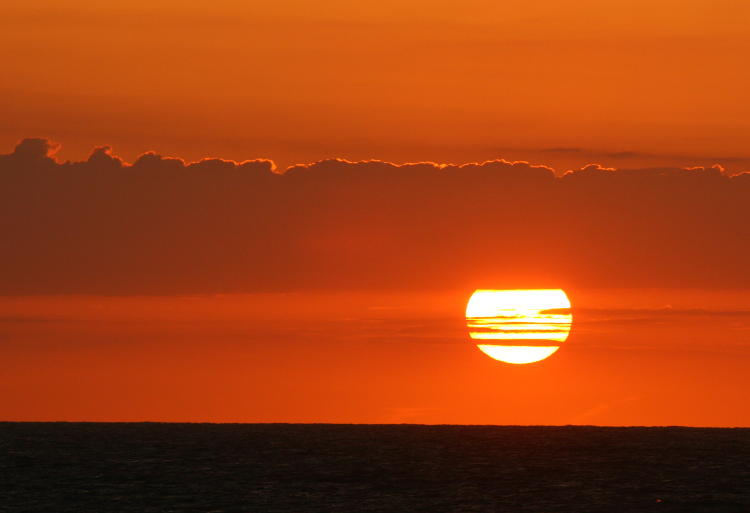
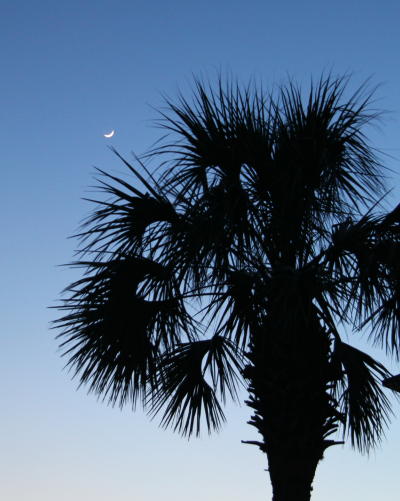 We now resume our adventures in coastal South Carolina, and if you’re at all familiar with the state, you know that it is symbolized, on license plates and numerous other materials, by a crescent moon over a palm tree; naturally enough, presented with the opportunity while there, I had to provide my own rendition.
We now resume our adventures in coastal South Carolina, and if you’re at all familiar with the state, you know that it is symbolized, on license plates and numerous other materials, by a crescent moon over a palm tree; naturally enough, presented with the opportunity while there, I had to provide my own rendition.
I confess, again, that while out at the coast, I am usually up well before dawn with the intention of catching sunrise on the beach. There are several reasons for this: my own area isn’t very conducive to sunrise shots, dawn on the beach and water is overall a very pleasing image, the colors are simply the best at these times, I’m out there before any beach gets too crowded, the sand is often pristine from the overnight tidal flow, and so on. And one other thing, that’s long been my goal to capture: the green flash.
Most people that know of this associate it with sunset, which is curious, because it can occur at sunrise too, and that’s a lot easier to capture on this coast. The gist is, given certain atmospheric conditions, just as the barest sliver of sun is on the horizon, it will be brilliant green – this happens for just a moment or two, and granted, it’s easier to time when the sun is going down because you know exactly when it’s going to reduce to that tiny bit. For sunrise, you have to be looking at the precise point on the horizon where the sun is going to pop up, to capture that bare moment of appearance rather than disappearance, but really, this isn’t that hard to do; the glow on the horizon just before sunrise easily pinpoints where the sun will rise.
So each morning of this week-long trip, I was out on location. We were staying at a ‘beachfront’ resort, so this should have been easy, but in reality we were a solid kilometer (6/10 mile) from the beach, the farthest accommodations available at that resort, it seems, and pretty austere at that. But I’ve had to do much worse, so I simply made sure I was up at least 45 minutes before astronomical sunrise so I could hike out to the ocean.
 The weather was notably clear for almost the entire week, which is good and bad; good for the opportunity for the flash, but otherwise it doesn’t produce much in the way of colorful skies and cloud patterns and all that. The first morning out there, I was standing ready with the Canon 100-300 L affixed, and dutifully fired off numerous frames as the sun peeked through. It looked green in the viewfinder, but the resulting photos didn’t support the idea very much, and I am forced to conclude that either my eyes interpreted it as green after seeing nothing but red-orange before, or the lens and exposure rendered it more yellow than it was. Call it a miss.
The weather was notably clear for almost the entire week, which is good and bad; good for the opportunity for the flash, but otherwise it doesn’t produce much in the way of colorful skies and cloud patterns and all that. The first morning out there, I was standing ready with the Canon 100-300 L affixed, and dutifully fired off numerous frames as the sun peeked through. It looked green in the viewfinder, but the resulting photos didn’t support the idea very much, and I am forced to conclude that either my eyes interpreted it as green after seeing nothing but red-orange before, or the lens and exposure rendered it more yellow than it was. Call it a miss.
After this attempt, I wandered the sand for a bit, concluding (and not being contradicted in the entire week) that this was the most boring beach I’d ever been on. Shallow slope, so the tide rolled a long ways in and out, and the waves were all ridiculously small, under half a meter at all times. Nothing ever washed up except for an occasional jellyfish, and even the shorebirds were scarce. With the new long lens, I was after nice detailed pelican shots, among anything else that I might find, and I have to say that I saw fewer pelicans than at any beach in the south, ever. The only species that I saw most days were the omnipresent sanderlings (Calidris alba) and a few least terns (Sternula antillarum.) Sheesh.
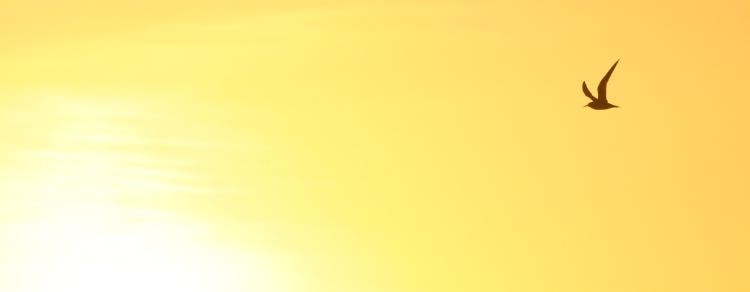
The next day I was out again, only this time with the long 150-600 lens and a tripod; even if I missed the green flash, I was hoping to get some nice bird portraits later on. Observing the horizon and my watch carefully, I waited for the sun to peek through, and the moment it did, I fired off numerous frames.
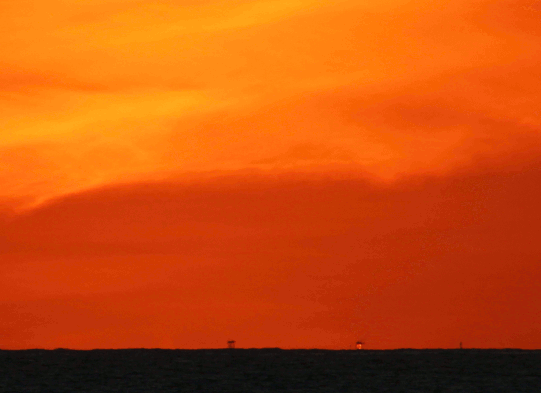 I don’t think anyone can deny it – that’s freaking green. This is significantly magnified of course, and I’m not sure whether or not anyone could have seen this by naked eye.
I don’t think anyone can deny it – that’s freaking green. This is significantly magnified of course, and I’m not sure whether or not anyone could have seen this by naked eye.
Before I go any further, I will point out that the first frame, held longer, was taken about a minute before, and what you’re seeing in there are fishing boats just over the horizon. I timed the pause between frames to match the frame rate of the camera, so this is as ‘real time’ as I can make it – maybe next time I’ll shoot video.
But what I suspect is that, like what I captured on a previous attempt at North Topsail Beach, the conditions for a green refraction are there more frequently than we suspect, but it requires special conditions to make it more visible without magnification, lasting longer and as the sun rises slightly higher. It might still be brief, but not as brief as this.
Curiously, there was an additional aspect captured as the sun fully rose above the horizon.
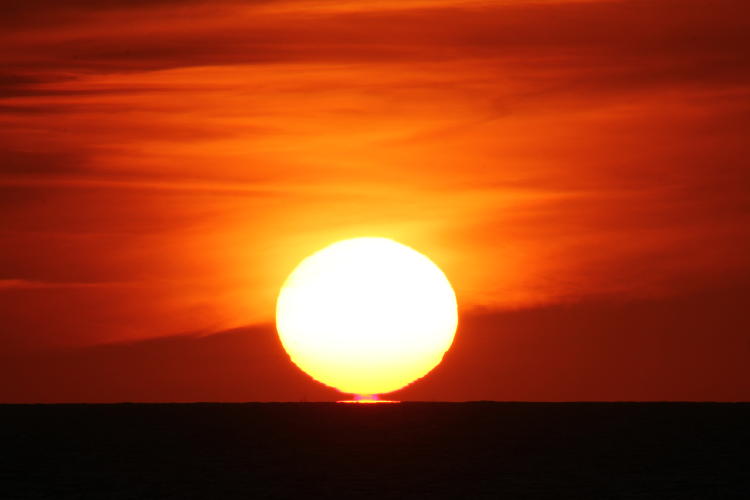
To give you an idea of the magnification from that lens, the image above is the full frame. Below, we take a better look at that trailing edge as it separated from the horizon:
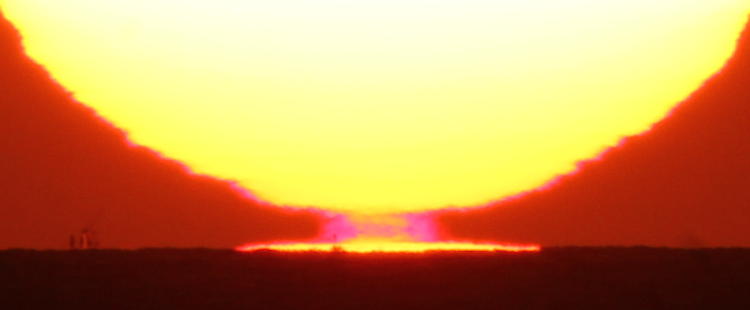
I find it interesting that this is pretty much the opposite of green on the color spectrum, and it’s probably a whole lot harder to spot due to the brightness of the sun. To lend some perspective, the exposures for the green flash were 1/320 second at f11, while this one was 1/400 at f25; almost eight times brighter for the fully risen sun (while still able to be viewed by eye without being blinded. Spotty, maybe, but not blinded.)
By the way, those don’t seem very sharp because of the exact same conditions that produce the colors in the first place: too much air and humidity. Everything is being distorted seriously, so much so that the sun may not even be above the horizon at all for these pics. Instead, this is actually a mirage, light bent by the atmosphere, while the sun is still just below the lip of the planet.
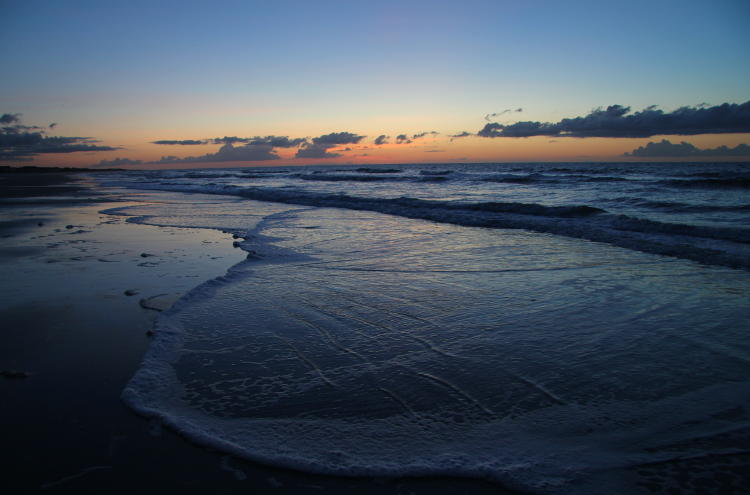
Before and after these attempts, I was still on the lookout for something that would make a decent scene, and took whatever opportunities presented themselves. Framing can make a big difference in such cases; here, the colors stopped just outside of the top of the frame, so I was trying for more foreground interest to be able to aim lower. One of the many jellyfish that would wash up served in one case.

If you look closely at the background clouds, between these two shots, you can see the minimal advancement, but also how two different layers/patches were moving at different speeds (this is probably a lot more visible when you’re flipping through the folder of images prepped for posts.) And if you look at this image and get an impression of where the sun is going to rise, you’re absolutely right.
One morning, I got slightly lucky in finding something else to work with on the sand.
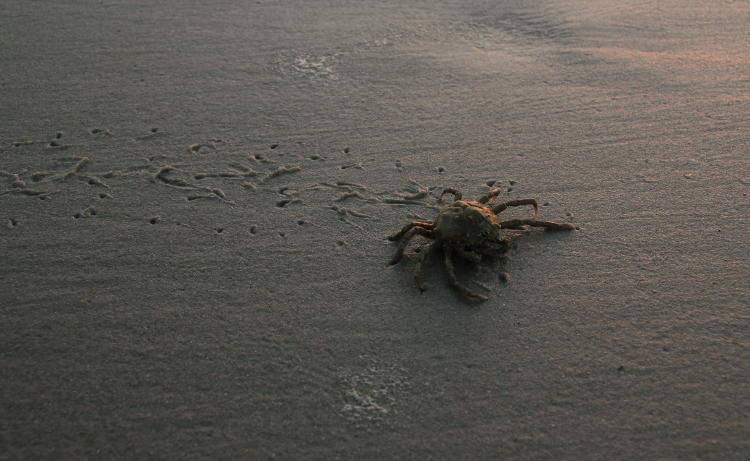
One of my old friends from Florida, a common spider crab (Libinia emarginata,) had been brought in by the tides, and sometime in the recent past had been attempting to make its way back to the water – they’re not at home on land, unlike a few other species in the area. It was motionless when I discovered it, perhaps starting to dry out and unable to breathe very well, so I only took a minute to snap a couple of quick, dramatic shots.
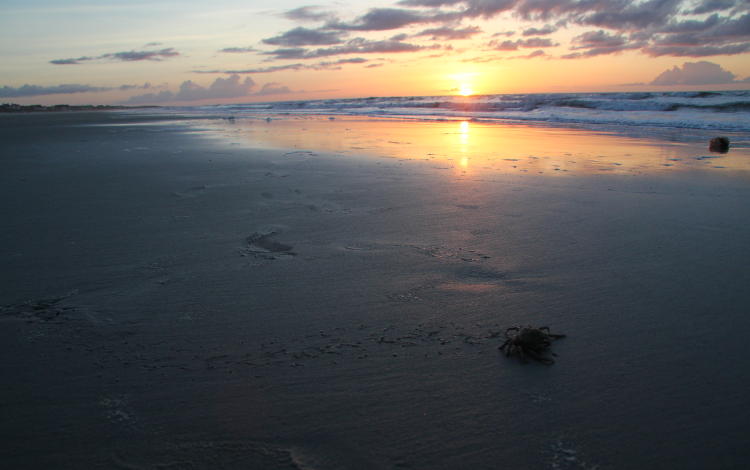
It still struggled feebly when I picked it up, so I went down into the breakers’ edge and deposited it into the water, making sure it got swept out into deeper water. And yes, that’s another jellyfish at the edge of the frame – I wasn’t carrying them back into the water because I have no inkling about the various species or the dangers thereof, so they were on their own.
I’m going to add a couple more shots in here, mostly just to thumb my nose at Mr Bugg, who was telling me how many pictures he was going to get on his beach trip, without having the faintest inkling how many I’d already gotten on mine.
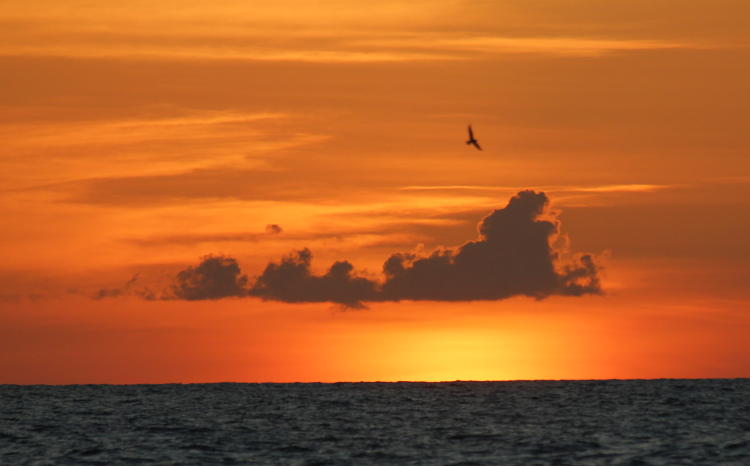
Both the image above and the one below were taken on the same day, all of six minutes apart, and demonstrate what kind of difference focal length can make. Above, 300mm, and below, 33mm.
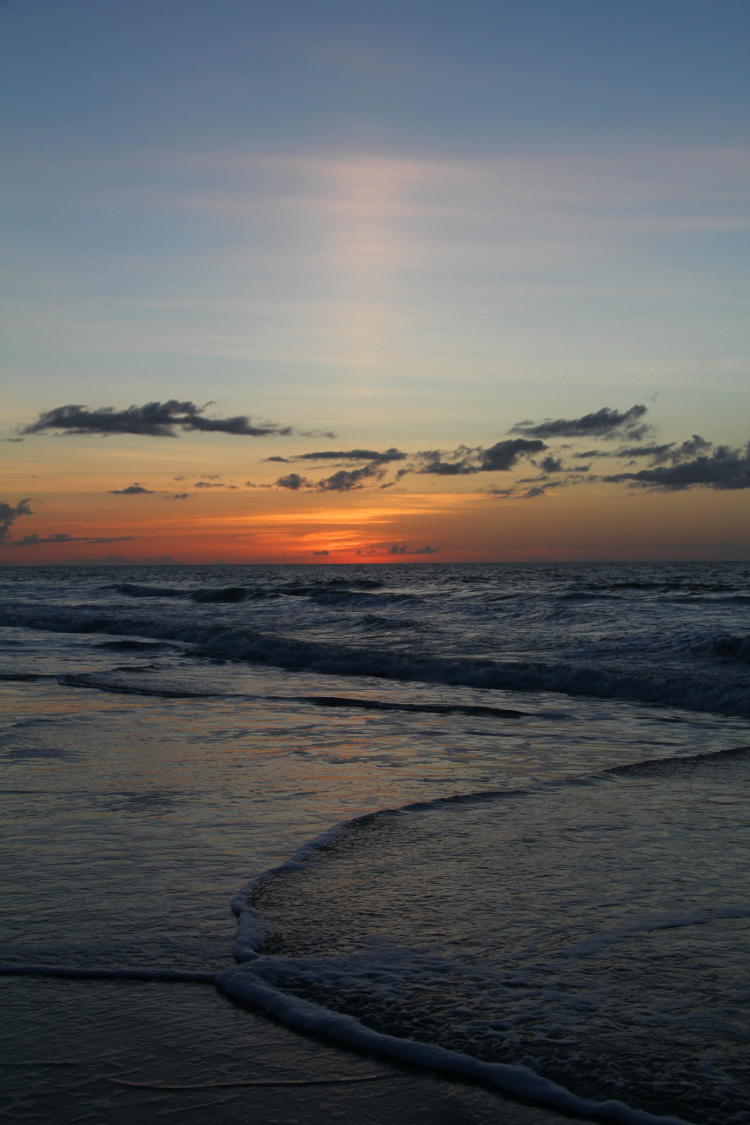
I wasn’t exactly sure how distinct this sun pillar was going to come out, because sometimes small variations in brightness just aren’t captured in the narrower dynamic range of photos – rainbows can be notoriously hard to make as impressive as they might appear to us – but I’m pleased with the result. Sun pillars come from high altitude ice crystals that are almost all oriented the same way, providing a few million airborne mirrors to bounce the sunlight over to us.
Going down to the beach at night can prove interesting, as well, and the first night there, I had out my ultraviolet flashlight just for giggles. Because of this, I determined by accident that Atlantic ghost crabs (Ocypode quadrata) will actually fluoresce in UV light – or to be more specific, the ‘hairs’ along the legs of the larger specimens will. It’s still pretty dim, so photographing such an effect means a long exposure, and on that first jaunt I wasn’t prepared with a tripod in hand. So a couple nights later, I set out with the mini-pod and started looking for crabs, hoping to get at least one to hold still for the several seconds it would take to get a sharp image. I could only judge from the LCD on the back of the camera afterward, and none of them were looking too promising, so I was pleasantly surprised to unload the card later and find what I did capture.
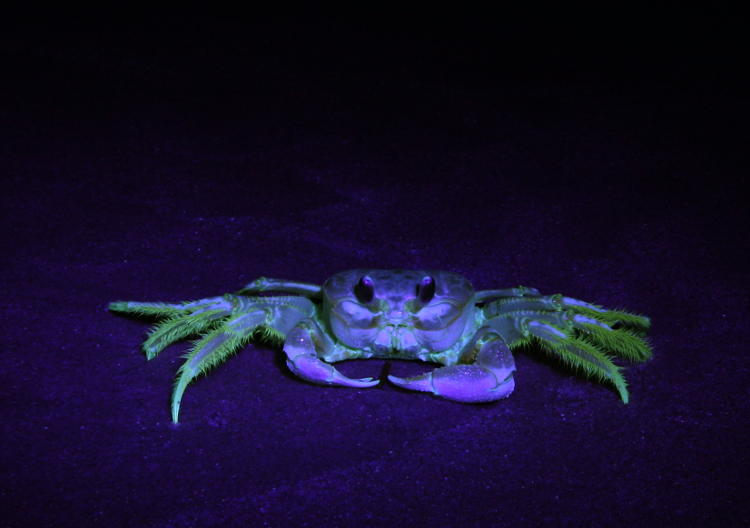
This is a four-second exposure, so my subject here was remarkably well-behaved. This is also altered a bit, because the camera captures UV light differently than our eyes see it, so this is color-corrected as close to what I remember it to be. Imagine those yellow hairs glowing a bit brighter, and you get the proper idea. There were a few people wandering the beach while I was out there, and I certainly piqued their morbid curiosity with my aberrant behavior, but I’m used to that by now.
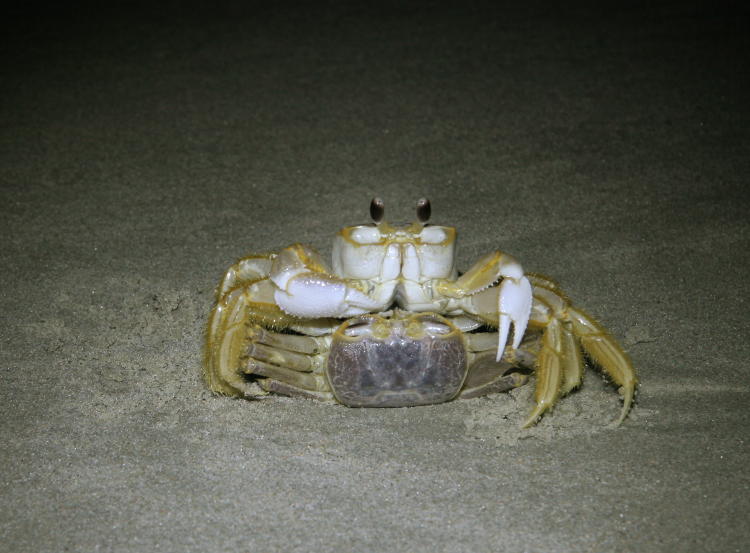
I’m fairly certain these are what mating crabs look like, and it was far from the only pair that I found that evening; this frame was shot by the light of the headlamp, and worked pretty well for that. Sure, call me cruel, but this was right out in public, when there were plenty of sand burrows to be found, so what did they expect? Freaking exhibitionists.
But I also made a mistake that night. As I was entering the beach area over the access boardwalk, I spotted some people with red flashlights poking around several dozen meters off to the left; I just figured they were busy with their own projects, and proceeded in the opposite direction so I wouldn’t bother them with my lights. Later on as I was returning up the beach, I was stopped by a kind gentleman who asked that we use the lights at a minimum and keep them aimed low and away from the water, because they’d had a loggerhead sea turtle (Caretta caretta) come up on shore earlier and lay her eggs. As you might recall, this was one of the things our summers trips have revolved around, because The Girlfriend is a sea turtle enthusiast, and I’m not blasé about them either. The man was speaking in the past tense, so I figured things were well over, and I was pretty much done for the night anyway and went back to our room soon after that.
The next morning, after doing my sunrise chasing, I glanced up to where I’d seen the red lights the night before and noticed a few people standing around, so I wandered up there; turns out they were volunteers for the South Carolina United Turtle Enthusiasts (SCUTE,) and were minding the nest until an experienced nest person could arrive. I took the opportunity to photograph the trails that the mother had made, going to and fro, and called The Girlfriend down to see them for herself.
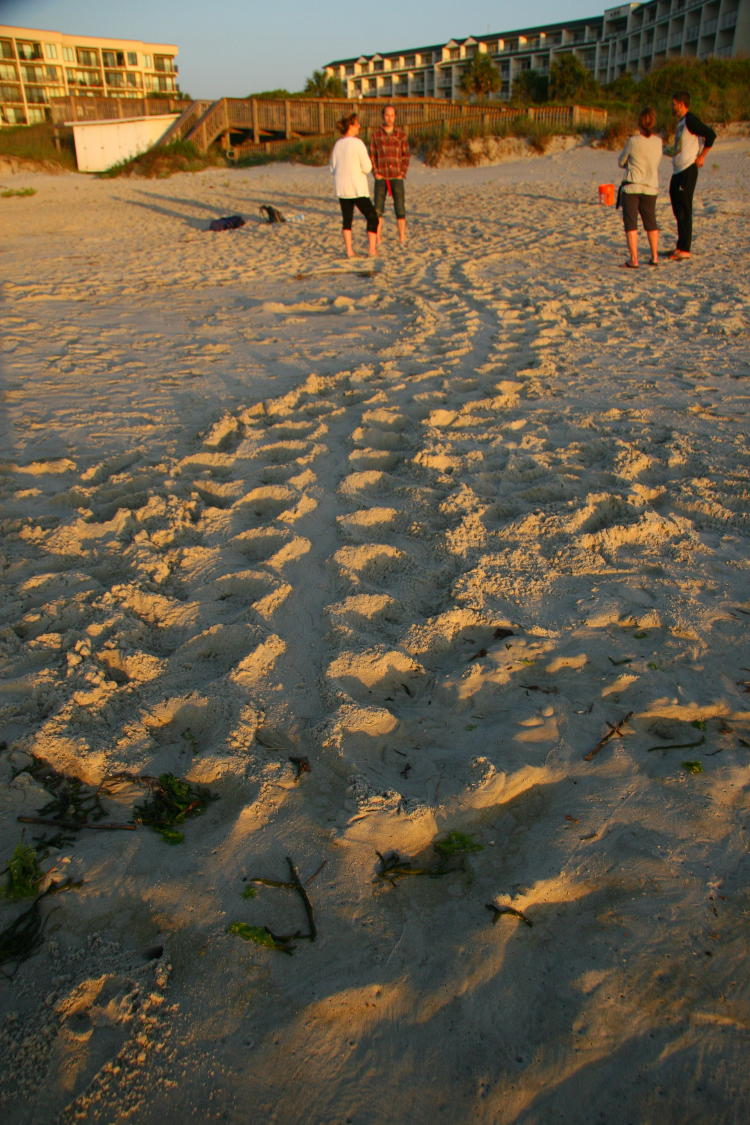
In the interim, I was talkng to the volunteers, and they asked if I was going to hang around for when they excavated and relocated the nest to a safer spot – it’s safe to say that my answer was in the affirmative. I also found out that the turtle might have been in the process of laying at the time that I first spotted the red lights, and I might have witnessed it had I gone over to investigate. Me and my un-nosy decorum.
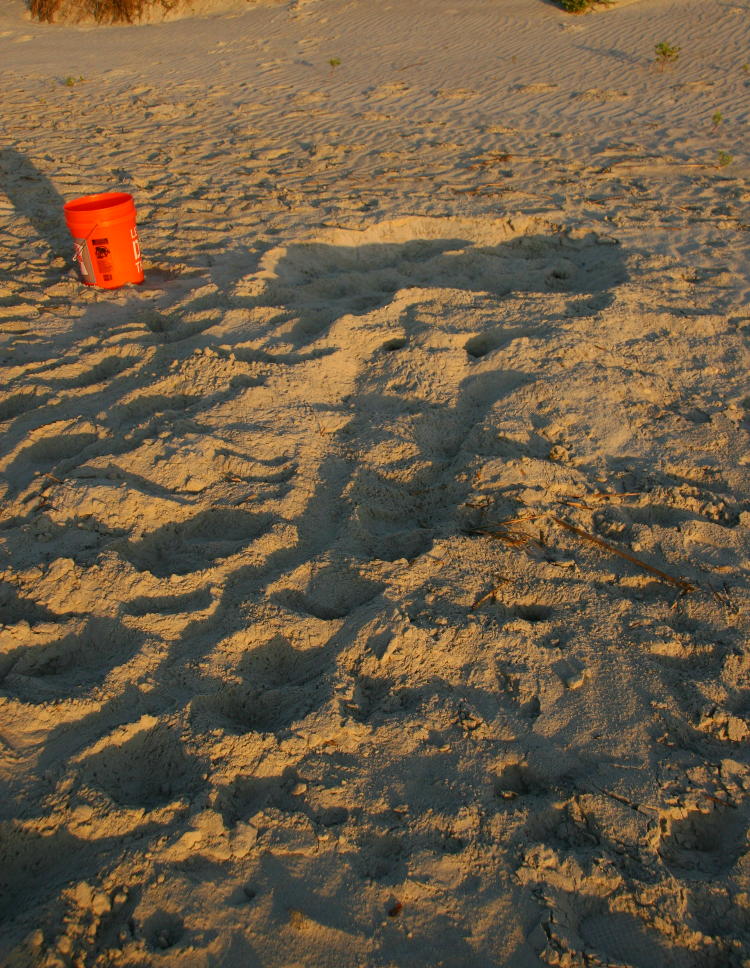
This is what the nest looks like, and what most people end up seeing, since virtually all of the laying takes place in the wee hours of the morning, like 2 AM or so – an hour after dusk was pretty rare, but it allowed a couple of the volunteers to watch the process on their own. Shortly afterward The Girlfriend arrived, just a couple of minutes after the nest expert had shown up, and we got to watch the whole process.

The guy in the foreground with the professional turtle nest probe (which looks remarkably like a pool cue) is Jeff McClary, co-founder of SCUTE, while immediately behind him is Glen Campbell, another member and the one who had approached me the night before, after having witnessed the actual laying. They’re probing the nest itself to determine the exact size and location, and as you can see, it’s not in the hollow where you might suppose – that’s where the female turned around after laying, which she did while facing inshore, so the nest is always offset towards the water (this is my understanding, anyway – don’t quote me on details.)
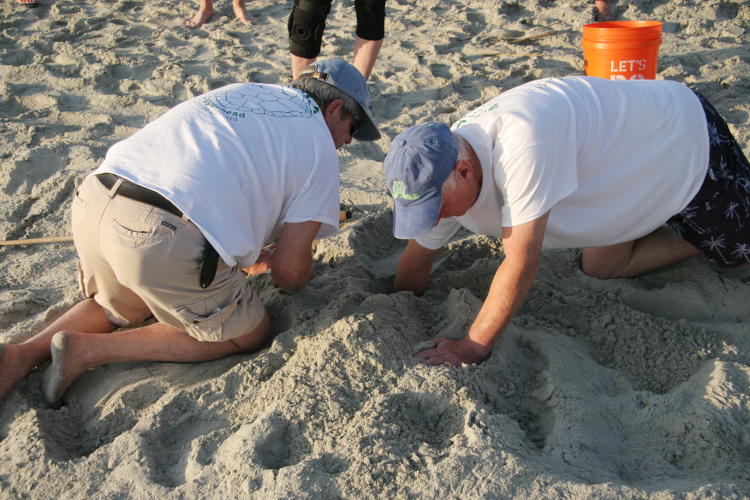
Now they’re carefully digging down until they feel the top of the nest – yes, it’s surprisingly deep. The young, when they hatch about two months later, will dig their way up through all that to the surface, then trek down to the water – you can see the distance in the previous pic (though this might vary a bit with the tides.)

Here, Glen carefully collects the eggs, taking care to keep them oriented the same way and keeping the original surrounding sand with them – there is a chance that it contains something from the mother that aids in their protection or hatching. The eggs are then moved to a safer location, less prone to being disturbed, and placed in a replicated nest, then marked carefully and GPS tagged – they’ll be monitored up until hatching. And yes I, at least, am toying with the idea of returning around that time. It’s a bit of a drive, and gestation period isn’t exact (some of it depends on conditions and temperature) so, maybe…
By the way, all of this was done with their permission, and I wasn’t crowding anybody – for the above frame, I held the camera out at arm’s length, aimed down, and shot blindly. It’s cropped slightly but otherwise well-aimed – I ain’t no amateur.
But for giggles, scroll back up and pay attention to the changing color cast, as the sun got higher and whiter. I had the camera set for full sunlight throughout, so no correction or compensation, and this was exactly how the light was colored as the morning progressed.
Our last dawn there was the only one where the sky didn’t fully cooperate, and I still managed to do something with it.
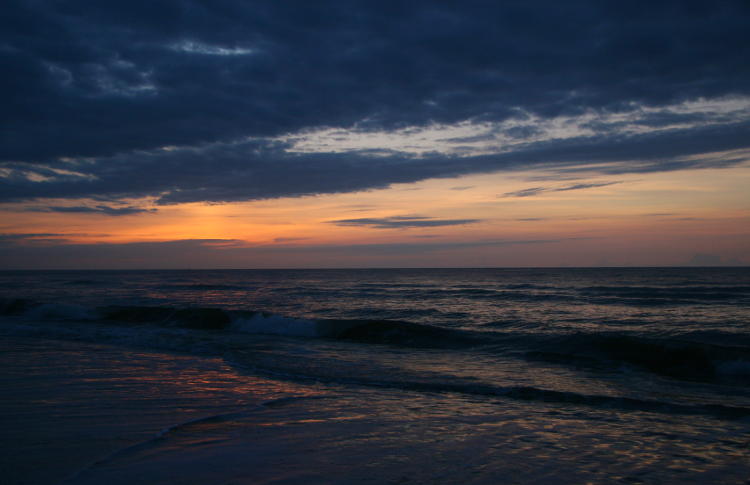
That certainly doesn’t look very promising, but I’ve been fooled before, and hung in there. Nonetheless, the sun did not appear until it was well above the horizon, fighting through the clouds. No green flash this time.
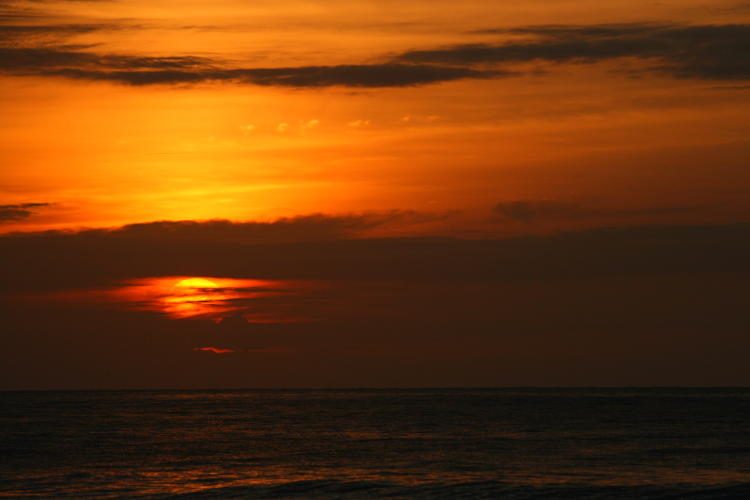
I could still do another post just with beach pics, while I have two more regarding this trip in the lineup – one solely dedicated to birds. So I’ll close with just one more dramatic shot, and be back as soon as I can. This post was only 2700+ words, 22 pics, and an animated gif (pronounced ‘gchechgchth,’) so, you know, about 15 minutes worth of work. No biggie.





















































